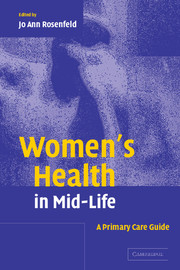Book contents
- Frontmatter
- Contents
- List of contributors
- 1 Introduction
- Part I Health promotion
- Part II Hormonal changes
- Part III Disease prevention
- 12 Prevention of coronary heart disease in women
- 13 Hypertension and stroke
- 14 Diagnosis and treatment of osteoporosis
- 15 Diabetes in mid-life women
- Part IV Cancer prevention
- Index
- References
13 - Hypertension and stroke
from Part III - Disease prevention
Published online by Cambridge University Press: 21 August 2009
- Frontmatter
- Contents
- List of contributors
- 1 Introduction
- Part I Health promotion
- Part II Hormonal changes
- Part III Disease prevention
- 12 Prevention of coronary heart disease in women
- 13 Hypertension and stroke
- 14 Diagnosis and treatment of osteoporosis
- 15 Diabetes in mid-life women
- Part IV Cancer prevention
- Index
- References
Summary
Case: M.M. is a 54-year-old obese woman who has not seen a physician in two years. She has a history of hypertension and high cholesterol. She works full time as an accountant for a medium-sized firm and has spent all her spare time for the past two years caring for her mother, who died two years after being incapacitated by a stroke. She has two married daughters who live across the country. She wants to control her hypertension so she doesn't end up like her mother and as a burden to her children.
Introduction
Hypertension has been termed the “silent killer.” Working with women to control their hypertension can positively affect their future health. Treating and controlling hypertension can decrease the risks of heart disease, death, myocardial infarction (MI), kidney disease, and stroke. Yet, fewer than half of individuals with hypertension receive treatment, and of those who are under treatment fewer than half are controlled well. Strokes may be prevented primarily or secondarily in individuals with certain risk factors, but the treatment is not completely effective.
Hypertension
Impact
Approximately one-fifth of adults over the age of 40 have high blood pressure. Hypertension is the most common cause of stroke in the UK and the most common cause of renal failure in the USA. Women are more likely than men to have hypertension, and the risk of hypertension increases with age.
Uncontrolled hypertension affects health profoundly negatively, and improving hypertension improves health.
Keywords
- Type
- Chapter
- Information
- Women's Health in Mid-LifeA Primary Care Guide, pp. 225 - 234Publisher: Cambridge University PressPrint publication year: 2004



